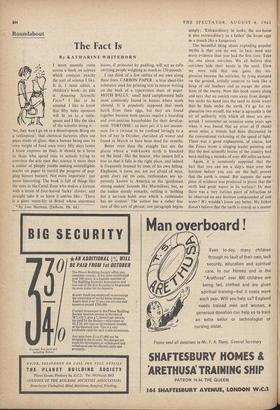Roundabout
The Fact Is
By KATHARINE WHITEHORN I HAVE recently come across a book on science which contains exactly the sort of science I like. It is, I must admit, a children's book; its title is Amazing Scientific Facts.* I like to be amazed. I like to know that fifty baby opossum will fit on to a table- spoon and I like the idea of the scientist doing it— `no, they won't go on to a dessertspoon. Bring me a tablespoon'; that chemical factories often use pipes made of glass; that a human being eats its own weight of food once every fifty days (some I know improve on that). It should be a boon to those who spend time in schools trying to convince the arts men that science is more than a matter of pimply youths making unintelligible marks on paper to record the progress of pop- ping bunsen burners. Not more important : just more interesting. The book is full of things like the man in the Canal Zone who makes a fortune with a strain of four-leaved 'lucky' clovers; and straight take it or leave it entries like : 'There is a giant water-lily in Brazil whose enormous
* By Jane Sherman. (Dobson, 10s. 6d.)
leaves, if protected by padding, will act as rafts carrying people weighing as much as 150 pounds.'
I can think of a few entries of my own along these lines. CARBON PAPER: a blue sheet-like substance used for printing text in mirror writing on the back of a typewritten sheet of paper. MOTH BALLS: small hard camphorated balls most commonly found in houses where moth abound. It is popularly supposed that moth, hatch from these eggs, but they are found together because both species require a hoarding and over-anxious householder for their develop- ment. TORTOISE: an inert pet; it is not uncom- mon for a tortoise to be confined lovingly to a box of hay in October, cherished all winter and found in March to have been dead for months.
Better even than the straight fact are the places where a well-known myth is knocked on the head—like the beaver, who cannot fell a tree so that it falls in the right place, and indeed is frequently brained by trees of his own felling. Elephants, it turns out, are not afraid of mice, goats don't eat tin cans, rattlesnakes are ap- parently known in America as the 'gentlemen among snakes' (sounds like Macmillan), but, as the author sternly remarks, rattling is 'nothing but a nervous habit over which a rattlesnake has no control.' The author has a rather fine turn of this sort of phrase; one paragraph begins simply: 'Extraordinary in looks, the sea-horse is also extraordinary as a father' (he keeps eggs in a pouch like a kangaroo).
The beautiful thing about exploding popular myths is that you do not, in fact, need any more evidence than you had the first time. Take the one about ostriches. We all believe that ostriches hide their heads in the sand. Then we were told that one gains this im- pression because the ostriches, by lying slumped on the ground, artfully contrive to look like a heap of old feathers and so escape the atten- tions of the enemy. Now this book comes along and says that an ostrich runs away from danger, but sticks his head into the sand to drink water that he finds under the earth. I'd go for ex- planation two myself, but what is agreeable is the air of authority with which all three are pre- sented. I remember an occasion some years ago when it was found that an error of (I think) seven miles a minute had been discovered in the conventional reckoning of the speed of light. There was a good explanation, of course, but the Times wrote a stinging leader pointing out that the best scientific brains of the country had been making a mistake of over 400 milei an hour.
Again, it is commonly supposed that the fact that you can see a ship's mast over the horizon before you can see the hull proves that the earth is round. But suppose the same piece of evidence was produced to prove that the earth had great waves in its surface? Or that there was a very curious piece of refraction to be observed on any horizon compounded of just water? We wouldn't know any better. My father doesn't believe that the earth is round. as a matter of fact; or at least he won't say it is, in the absence of evidence he can judge personally; and is fond of comparing the relative amounts of evi- dence produced to support (1) theories of re- ligious miracles, (2) theories of scientific fact, and (3) theories about the Loch Ness Monster. It is all one to him.
The scepticism of such a liberal arts man is a fine thing to behold: a granite monolith im- peryious to weather and change, but it seems sad that the stand they take also bypasses the sheer fascination of these facts, true or false.
The defenders of science in schools are apt to contend that it is useful—which it probably isn't: it is a lot more use to have reams of poetry or philosophical chat inside the head than to know the mating habits of the camel. They con- tend that it is practical—which anyone who has ever seen a scientist trying to rent a house or get the laundry back on time would be apt tc contest. They also contend that it is true: and it may be--for the time being.



































 Previous page
Previous page